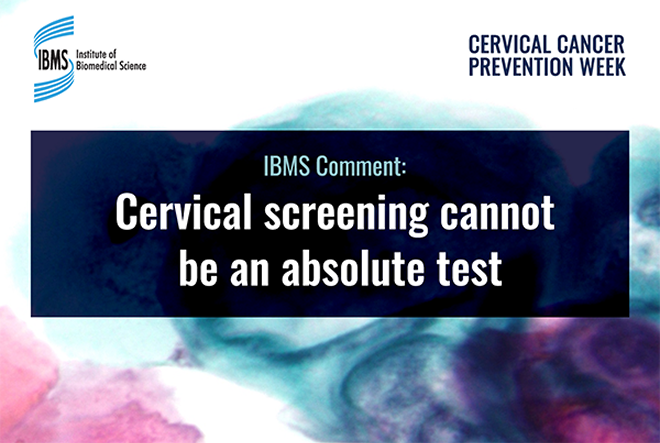Position Statement: Cervical screening cannot be an absolute test

In respect of Cervical Cancer Prevention Week, IBMS Council share a position statement highlighting the importance of cervical screening tests
There is no doubt that population screening saves lives. Participation in cancer screening programmes substantially reduces the incidence of and mortality from cancer. Screening programmes are unique: we ask asymptomatic individuals to participate in a programme for the common good of the target population and accept that the programme may on occasions lead to unnecessary investigations. This is the delicate balance of any screening programme between sensitivity and specificity. The ethical balance of screening is between preventing cancer in the individual and avoiding harm at a population level to the wider society.
A screening test is not the same as a diagnostic test. Therefore, no screening programme can function without a small percentage of false negative and false positive results; that is an inherent consequence of screening. Complex programme-wide quality assurance (QA) systems, comprehensive training programmes and tight internal quality control (IQC) within laboratories are developed to reduce false negative and false positive results but they can never be eliminated entirely.
Screening programmes must also establish standards and have comprehensive audit in place to learn from both false negative and false positive results. This learning must be used to address any shortcomings in the programme and further drive down the false negative and false positive rates. This continual assessment and improvement cycle ensures that standards are maintained and public confidence in the programmes is increased leading to improved participation.
Screening programmes can only be successful if the target population attend their screening appointments. Within the cancer screening programmes one of the greatest risk factors in developing cancer is not participating in screening. This creates a public education dilemma. To reduce the incidence of and mortality from cancer within the cancer screening programmes those who are invited need to attend for screening.
If the programme emphasises the small number of false negatives that will result from screening, there is the risk of lowering confidence in the programme and consequently this risk lowering participation. If a screening programme raises unreasonable expectations, then there is again a risk of loss of confidence when the inevitable false negatives come to light and the programme may be accused of ‘failing’. This is a difficult message to convey to participants in any screening programme.
For national screening programmes to succeed it is vital that the limitations and potential harm that screening can do is presented in a balanced way with participants, while referencing the strong evidence base gained from 30 years of screening programme data, which shows the life-saving benefits from participation.
Screening programmes err on the side of caution to avoid false negatives, but that must be balanced against the risk of over investigation and over treatment. Introducing the concept of absolute confidence in any screening test would inevitably lead to a more cautious approach and increase the number of false positives leading to over investigation and over treatment with potentially significant adverse clinical impact on participants.
Unrealistic expectations of a screening test put pressure on the service and may increase the likelihood of legal action in an increasingly litigious environment. There is overwhelming evidence demonstrating the benefit of screening programmes, which is sometimes undervalued by the public and the media. It can be difficult to reconcile with the small numbers of highly publicised personal tragedies that result from false negative results, especially within the cancer screening programmes.
The screening community, of which the laboratory service is a vital component, must work together to ensure that a fear of litigation and the impact of false negative results do not drive towards an over cautious approach to testing leading to over referral and the loss of the common good of all our screening programs.
IBMS Position Statements - submit your request
The IBMS is open to hearing and addressing our members’ issues and representing the profession’s interests across the four nations, and beyond. Therefore, we invite members to raise topics for IBMS position statements and opinion pieces.
Before submitting:
For your topic to merit the production of a position statement or opinion piece it must be of significance to a majority of the membership or, exceptionally, to a single discipline or professional group within the membership, and be a key issue for the Institute.
Suggestions for topics and the rationale behind the suggestion should be sent by email to communications@ibms.org entitled “IBMS Position Statement” so that it can be forwarded to IBMS Chief Executive Jill Rodney and the appropriate IBMS Council members – who will then decide upon the suitability of the proposal within 5 working days.
In the event that your proposal is accepted, a suitable lead author will be appointed - usually from the IBMS Council, panels or staff. The lead author will have 14 days to respond and then send their statement/piece to Council for approval. Unless revisions are requested, the statement will be published within a further 5 working days.
Of course, these represent maximum turnaround times and we will do everything in our power to ensure quicker response rates - particularly if the issues are time-sensitive.


